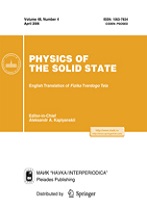|
This article is cited in 3 scientific papers (total in 3 papers)
Polymers
Unoccupied electronic states and potential barrier in films of substituted diphenylphthalides on the surface of highly ordered pyrolytic graphite
A. S. Komolova, E. F. Laznevaa, N. B. Gerasimovaa, V. S. Soboleva, S. A. Pshenichnyukb, N. L. Asfandiarovb, V. A. Kraikinc, B. Handked
a Saint Petersburg State University, St. Petersburg, Russia
b Institute of Molecule and Crystal Physics, Ufa Federal Research Centre, Russian Academy of Sciences, Ufa, Russia
c Ufa Institute of Chemistry – a Separate Structural Unit of the Ufa Federal Research Center of the Russian Academy of Sciences, Ufa, Russia
d AGH University of Science and Technology.
Faculty of Material Science and Ceramics. Al. Mickiewicza 30,
30-059 Kraków, Poland
Abstract:
The results of a study of the unoccupied electronic states of ultrathin films of bis-carboxyphenyl-phthalide (DCA-DPP) and bis-methylphenyl-phthalide (DM-DPP) up to 8 nm thick are presented. The studies were carried out by total current spectroscopy (TCS) technique in the energy range from 5 eV to 20 eV above $E_{\mathrm F}$ during thermal vacuum deposition of these organic films on the surface of highly oriented pyrolytic graphite (HOPG). The energy $E_{\operatorname{vac}}$ relative to $E_{\mathrm F}$, that is, the electronic work function of the DM-DPP films, at a film thickness of 5–8 nm was 4.3 $\pm$ 0.1 eV. The electronic work function of the DCA-DPP films was 3.7 $\pm$ 0.1 eV. The structure of the maxima of the unoccupied electronic states of DCA-DPP films and DM-DPP films in the studied energy range is determined. The properties determined of DCA-DPP and DM-DPP films are compared with the properties of films of unsubstituted diphenylphthalide (DPP). According to our analysis, –CH3 substitution of the DPP molecule practically did not affect the height of the potential barrier between the film and the HOPG surface, and –COOH substitution of the DPP molecule led to an increase in the height of the potential barrier between the film and the HOPG substrate surface by 0.5–0.6 eV. Substitution of DPP molecules with –COOH functional groups which represents formation of DCA-DPP molecules led to a shift of two peaks of the experimental total current spectra located at energies in the range from 5 eV to 8 eV above $E_{\mathrm F}$, by about 1 eV towards lower electron energies.
Keywords:
phthalide molecules, ultrathin films, highly oriented pyrolytic graphite, electronic properties, low-energy electron spectroscopy, interface potential barrier, density of electronic states.
Received: 15.09.2020
Revised: 04.10.2020
Accepted: 05.10.2020
Citation:
A. S. Komolov, E. F. Lazneva, N. B. Gerasimova, V. S. Sobolev, S. A. Pshenichnyuk, N. L. Asfandiarov, V. A. Kraikin, B. Handke, “Unoccupied electronic states and potential barrier in films of substituted diphenylphthalides on the surface of highly ordered pyrolytic graphite”, Fizika Tverdogo Tela, 63:2 (2021), 299–303; Phys. Solid State, 63:2 (2021), 362–367
Linking options:
https://www.mathnet.ru/eng/ftt8191 https://www.mathnet.ru/eng/ftt/v63/i2/p299
|


| Statistics & downloads: |
| Abstract page: | 122 | | Full-text PDF : | 35 |
|



 Contact us:
Contact us: Terms of Use
Terms of Use
 Registration to the website
Registration to the website Logotypes
Logotypes